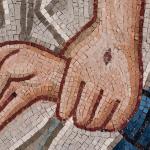The American Society of Civil Engineers designates the Panama Canal as “one of the seven wonders of the modern world.” Located in the western hemisphere in Central America, it greatly reduces the shipping route between East and West so that ships do not have to navigate the dangerous southern tip of South American–Cape Horn. More tonnage of goods is transported through the Panama Canal than any other canal in the world.
So, as the world’s most important waterway, the nearly fifty-mile Panama Canal in the narrow Isthmus of Panama joins the Pacific and Atlantic oceans together with a series of locks on both sides of the artificial Gatun Lake. The canal’s construction was begun by the French in 1881 and finished by the USA in 1914. Tens or thousands of workers died during its construction, mostly of malaria.
The U.S. controlled the Panama Canal until 1977. Then the U.S. and Panama jointly controlled it until 1999. That’s when U.S. President Jimmy Carter had negotiated for the canal’s total ownership to be turned over to Panama. It is a huge source of revenue for the nation of Panama, and that amount of income is about to grow much larger for the Panamanians.
Yesterday, a massive new HOV lane was opened in the Panama Canal. It took 40,000 workers nearly ten years to dig with large, earth-moving equipment to complete this $5.4 billion, additional project. This increase in waterway will nearly triple the Panama Canal’s current shipping capacity. Megaships carrying up to 14,000 containers will traverse this extra lane. Major U.S. ports have been spending billions of dollars to upgrade their facilities in order to be able to accommodate these new megaships.
For several decades I have believed that global shipping of goods was going to become an increasingly important source of world income. Why? Bible prophecy. Revelation 18 tells about the city of Babylon becoming that greatest city in the world, largely because of its water port. For this to literally happen, the ancient city of Babylon on the Euphrates River in present-day Iraq must in the future be rebuilt.
But most New Testament scholars think Babylon in Revelation 18 should not be interpreted literally. Many think it refers to Rome and that its author only intended this prophecy to refer to the Rome of his time. Rome has always been situated on the Tiber River which flows four miles before emptying into the sea.
These scholars would have been correct about “Babylon” in Revelation 18 being a code word for Rome if Jesus would have returned with his kingdom during that first century. But, of course, that didn’t happen. Consequently, Revelation 18 should be interpreted literally just as some futurists treat it.
John the Revelator begins his prophecy about the literal city of Babylon by saying an angel appeared to him in an apparent vision, saying “with a mighty voice, ‘Fallen, fallen is Babylon the great! It has become the dwelling place of demons, a haunt of every foul spirit, . . . For all the nations have drunk of the wine of the wrath of her fornication, and the kingso of the earth have committed formication with her, and the merchants of the earth have grown rich from the power of her luxury'” (Rev 18.2-3). He adds, “‘mighty is the Lord God who judges here. . . . Alas, alas, the great city, Babylon, the mighty city! For in one hour your judgment has come'” (vv. 8, 10).
John also elaborates about Babylon’s great wealth that will make it the world’s greatest city. He says, “And all shipmasters and seafarers, sailors and all whose trade is on the sea, stood far off and cried out as they saw the smoke of her burning, ‘What city was like the great city!’ And they threw dust on their heads, as they wept and mourned, crying out, ‘Alas, alas the great city, where all who had ships at sea grew rich by her wealth! For in one hour she has been laid waste” (vv. 18-19). He also says, “your merchants were the magnates of the earth” (v. 23). So, some of the richest people in the world in the latter days will be those who make their living from global shipping.
Besides Babylon becoming such a wicked city, John says, “in you was found the blood of prophets and of saints, and of all who have been slaughtered on earth” (v. 24). Here, John seems to go beyond the literal city of Babylon to refer to that mystery Babylon of Revelation 17, which is a lesson for another day. Thus, in the future the literal, rebuilt city of Babylon will be the epitomy of false religion that oppresses, persecutes, and puts to death God’s people. This is all the more reason for God to bring violent judgment on Babylon.
But how will God judge and therefore destroy this rebuilt city of Babylon in the future? John relates, “Then a mighty angel took up a stone like a great millstone and threw it into the sea, saying, ‘With such violence Babylon the great city will be thrown down, and will be found no more'” (v. 21). I think this means that this great, future city of Babylon will suddenly sink out of sight. How? I suspect that the ruins of Babylon at present Hillel, where Babylon will surely be rebuilt, rest upon bitumen underground and that it will somehow be ignited and cause Babylon to burn and sink in one literal hour. What a sight it will be. For those who make their living by shipping, they will wail. But for those whom Babylon ill-treated, they will rejoice.
How will Babylon become such a wealthy port? That also is a lesson for another day.
















